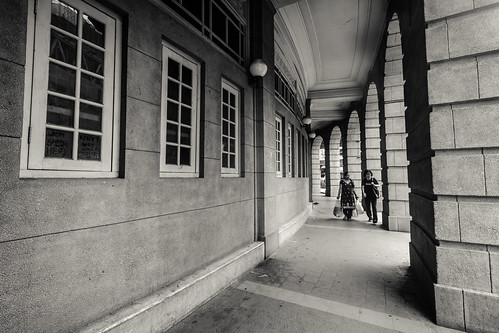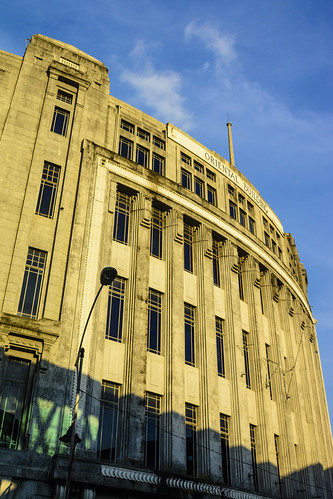Oriental Building: The tallest Art Deco masterpiece of Kuala Lumpur
 |
| The Oriental Building located at the corner of Jalan Tun Perak and Jalan Melaka |
Art Deco architectural style started to gain popularity and became the preferred choice of architectural style by the building owners in then Malaya (now Malaysia) especially in major towns like Kuala Lumpur, Penang and Ipoh between early 1930's and 1940's.
Art Deco architecture started to be popular worldwide since 1925 after the World War I until early 1940s when its popularity declined after the World War II. It is also referred to as the interwar period. One of the largest Art Deco buildings in Kuala Lumpur besides the Central Market is the Oriental Building. According to a report by The Straits Times newspaper dated 26 November 1931 entitled "Big building for Kuala Lumpur" the construction work for a five-storey building would commence soon. The building, once completed, would stand at 82ft tall and would be the tallest building in Kuala Lumpur. It would also change the skyline of Kuala Lumpur and would add the welcome liveliness to the commercial centre which seemed to be stagnant at that time perhaps partly because of the Great Depression when its effect was felt worldwide.
The report also stated that the Oriental Building was built for the Oriental Government Security Life Assurance Company. The company responsible for its construction was said to have been Gammon (Malaya) Ltd. while its architect was Messrs. Booty and Edwards. There was also a consulting reinforced concrete specialist by the name of Mr. Steen Sehested entrusted to oversee the concrete work. Later I learnt that the architect of this handsome building was Arthur Oakley Coltman or more popularly known as AO Coltman who worked as a manager for Messrs. Booty & Edwards based in Kuala Lumpur. The Oriental Building is located at the corner of Java Street (renamed Mountbatten Road before it was later changed to Jalan Tun Perak) and Malacca Street (now Jalan Melaka).
 |
| The Oriental Building captured in 2016 |
Upon its completion, The Straits Times came up with its report titled “Tallest building in Kuala Lumpur – Insurance company’s new headquarters” dated 26 December 1932 stating that The Oriental Building was ready for use and would be officially opened the next day on 27 December 1932 by the British Resident of Selangor, Mr. T.S. Adams.
It was reported that The Oriental Building which housed the new Malayan headquarters of the Oriental Life Assurance Company Ltd. standing in the centre of Kuala Lumpur and finished in white and grey tone was an impressive symbol of the commercial life of this city. From its roof, 85 feet above the pavement the building commanded a majestic view and was crowned the tallest building in Kuala Lumpur. Triangular in shape it covered an area of 5,000 square feet with a curved facade of 123 feet in length. The building was five storeys in height while the offices of the Oriental Life Assurance Company Ltd were situated on the entire third floor over an area of 3,310 square feet.
 |
| The Oriental Building upon its completion in 1932. Photo by OY Kok. Reproduced from The Straits Times archive. |
The building is of reinforced concrete frame with brick panelling from the design of Mr. Steen Sehested. It was finished in two kinds of external plaster, grey and white, which was executed by hand from local small tones and cement and was unique in that no was sand was used. It was reported in the The Straits Times that its ground floor which included a shop, godown, basement and the usual conveniences was self-contained. The basement itself was rat-proof and in case of floods doors could be fitted into specially constructed grooves over the basement windows to prevent water from entering the building. Tiles made in England decorated the staircases and passages while office floors were covered with Italian tiles.
 |
| The Oriental Building from an old postcard. The postcard was published by A.S.M.K & Co, Singapore. Year not stated but it is believed to be in 1950s. |
In The Straits Times report nowhere it was mentioned that the building was designed in Art Deco style because this architectural style was given its name as Art Deco only in 1966 by the renowned architect Le Corbusier, who penned a series of articles in his journal L’Esprit nouveau under the headline “1925 Expo: Arts Déco”.
However the building was designed obviously in Art Deco style judging by the ubiquitous Art Deco characteristics it possesses. In fact this is a fine example of an Art Deco architecture which was popular during the interwar period beginning in 1925 and the popularity declined after the World War II. One of the most prominent traits of Art Deco building is its flag pole at the top of its building.
Besides, its tall and slim windows are another Art Deco significant identity. Art Deco also frequently utilises contrasting materials to emphasize differences in colour and texture. The white frieze with a bas-relief of interlocking coins/disc frames the entire panel on its exterior which is flanked by two tower-like pylons. The projecting panels of walls in between the slim windows are stepped, creating the illusion of depth. Stepped pillasters begin at the 3rd floor, flanking the windows. The sharp, clean lines that beam out from the archway suggest a sunburst motif. These are the significant characteristics of Art Deco architecture which can be found all over the world.
Besides, its tall and slim windows are another Art Deco significant identity. Art Deco also frequently utilises contrasting materials to emphasize differences in colour and texture. The white frieze with a bas-relief of interlocking coins/disc frames the entire panel on its exterior which is flanked by two tower-like pylons. The projecting panels of walls in between the slim windows are stepped, creating the illusion of depth. Stepped pillasters begin at the 3rd floor, flanking the windows. The sharp, clean lines that beam out from the archway suggest a sunburst motif. These are the significant characteristics of Art Deco architecture which can be found all over the world.
Although the building is currently left vacant it is learnt that the building is still leased to a local bank and perhaps it is waiting to be renovated before being occupied again. Let’s hope it is well taken care of no matter who the owner is. This elegant edifice deserves to be safeguarded and preserved as it is one of the national precious heritage.
 |
| Along the building's five-foot way |


Great work. Please consider (if you hv not yet done so) publishing a book wth all yr wonderful and informative research compilations.
ReplyDeleteThis comment has been removed by the author.
DeleteCan I know how do you accessed this building?
ReplyDeleteThe building is located in the public area and the compound can be accessed by any Tom, Dick and Harry but not its interior because it is a private property.
DeleteGreetings. Wonderful page. In love with beauty of heritage. Do you know who currently is the owner of Oriental Building and what are their plans? Seems like such a waste.
ReplyDeleteIt's awesome designed for me to have a web site, which is helpful in support of my experience.
ReplyDeletethanks admin
Hi there it's me, I am also visiting this web page daily, this website is
ReplyDeleteactually nice and the viewers are actually sharing good thoughts.
This site really has all the information I wanted about this subject and didn't know who to ask.
ReplyDeleteI am glad if the info provided here could benefit people who are interested in heritage buildings especially in Malaysia
DeleteWhat's up, its pleasant article regarding media print, we all understand media is a fantastic source
ReplyDeleteof data.
Yes you can say that again. It is a valid record of the nation's history.
DeleteYou are so awesome! I don't think I have read through something like that
ReplyDeletebefore. So good to discover someone with some genuine thoughts on this
subject. Seriously.. thanks for starting this up.
This website is one thing that is required on the web, someone with a bit of originality!
Thank you for your favourable comment
DeleteNice respond in return of this question with genuine arguments and
ReplyDeletedescribing the whole thing concerning that.
I've never heard of an Art Deco building in Malaysia. I think this is a very historic building. Thanks a lot for your information. biesterbosgroep.nl
ReplyDeleteThanks for visiting my blog. Actually there are numerous Art Deco buildings in Malaysia especially in major town such as Kuala Lumpur, George Town in Penang and Ipoh. Most of them were designed by foreign architects who either worked here as a government servant or who practised their architecture in a private architecture firm. In fact there are a few other Art Deco buildings in this blog itself if you browse more pages :)
DeleteAmazing blog, thanks for sharing. At a time when internet popularity is spreading at a rapid pace its important that you use this platform for knowing about different things easily. Reporters as well as bloggers from different portals of the world are updating these blogs on regular basis.
ReplyDeleteSecurity Company Bexleyheath
Security Company Dartford
Security Company Welling
Security Company Greenhithe
Security Company Gravesend
Security Company Bromley
Security Company Sidcup
Security Company Woking
Security Company Staines
Security Company Redhill
Security Company Croydon
Security Company Wimbledon
This is great and informative writeup. I loved this building and take a few shot every time i passed by.
ReplyDeleteCool and I have a nifty give: average price to remodel a house
ReplyDeleteI really liked the blog keep on sharing lovely posts also do visit
ReplyDeleteMotels in Iowa
Hotels in Iowa
After the Second World War, it was the premises of the Information Dept headed by Tan Sri Mubin Sheppard, then a civil servant. It was here in 1946 that he met Ralph Elton, a film director from the Crown Film Unit in London who told him that the film equipment used by the British army was going to be sold off to commercial interests in Singapore. Sheppard, who had been interned as a prisoner-of-war in Changi, had developed the idea of setting up a film unit after the war. He forthwith set into motion events that led to the buying of the film equipment & the setting up of a film unit which became the largest film unit in the Commonwealth. This building was the first premises of the Malayan Film Unit (MFU) before its move to the location behind Lever Brothers in Bangsar. In 1963, it was renamed Filem Negara Malaysia.
ReplyDeleteThank you Tuan for sharing the info and for dropping by
DeleteThank you Zain. I was starved of articles like this on architecture in Malaysia, particularly heritage buildings. Strongly enthusiastic about architecture and design, iy was a pleasure reading this. You have put in so much passion, time, energy and research into this, which is clearly evident. I look forward to reading more of your articles.
ReplyDeleteThank you Karen for dropping by and for leaving your comment.
Delete